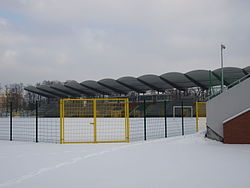Czarna Woda (Kaczawa)
Poland river stubsRivers of Lower Silesian VoivodeshipRivers of PolandTributaries of the Kaczawa

Czarna Woda (Polish for "black water") is a river of Poland, a tributary of the Kaczawa, which it meets in Legnica. The Czarna Woda is 48km long. It flows through Lower Silesian Voivodeship and has water falls in Legnica. The river also flows through marshes at Wierzbowskie taking a westerly direction from the village of Wierzbowa. The river flows through Legnica District. Its main tributaries are the Skora and Siekierna Rivers. Towns on the river include Wierzbowa, Rokitki, Grzymalin, Bukowna, Rzeszotary and Legnica.
Excerpt from the Wikipedia article Czarna Woda (Kaczawa) (License: CC BY-SA 3.0, Authors, Images).Czarna Woda (Kaczawa)
Wały Północne, Legnica Bełdów
Geographical coordinates (GPS) Address Nearby Places Show on map
Geographical coordinates (GPS)
| Latitude | Longitude |
|---|---|
| N 51.222948 ° | E 16.179116 ° |
Address
Wały Północne
Wały Północne
59-220 Legnica, Bełdów
Lower Silesian Voivodeship, Poland
Open on Google Maps











